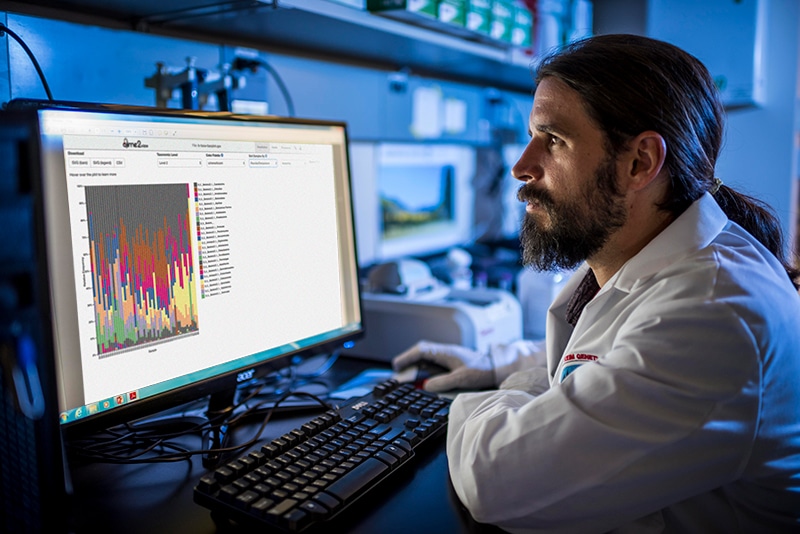Like everyone else, the COVID-19 pandemic meant Greg Caporaso and his team of researchers were facing a calendar of canceled events, including training sessions for an important piece of software that international researchers need to study microbiomes. A user manual just won’t suffice.
So, the team from the Pathogen and Microbiome Institute at Northern Arizona University took the only option available: Zoom. Looking at the hundreds of in-person sessions they’d done in the past, the team got together and asked two all-important questions: How do we transition to effective virtual training, and how do we reach as many people as possible?
Learn more about open source bioinformatics software platform QIIME 2.
What they came up with is a playbook of how to do complex scientific training virtually while maximizing opportunities to learn skills, build relationships and make training more accessible to researchers throughout the globe, with different pre-existing skill and budget levels and a diversity of abilities. Not only did this lead to a published article to help others replicate their success, but the NAU team plans to keep such opportunities available in the future even when in-person trainings are allowed again.
Based on the turnout—75 attendees from at least 25 countries, with registration sold out in five minutes—it was a success. A second conference in January, which allowed the team to reuse much of the material, had 57 participants.
“While we all love that chance to see the world while doing our job, it’s really important to us to make our software easy to use and accessible to anyone who wants to use it,” said senior research software engineer Matthew Dillon, who led the pivot from in-person to Internet. “The virtual format helps us reduce our travel load, freeing up time to focus on new workshop material and new features.
The team brainstormed about the strengths and weaknesses of the latest in-person workshop agenda and format and discussed ways to amplify the strengths and overcome weaknesses and while moving to a virtual format. They prerecorded videos so instructors could engage more with participants during sessions; they made videos available for viewing 24 hours early; and they scheduled in significant time for interactive, hands-on learning with the software. They also scheduled breaks; told participants to put questions in the chat that instructors could follow up on later; and made the videos available on YouTube at no extra cost, though those viewers were not able to actively participate.
The virtual format also meant more accessibility for participants throughout the world and those with less funding. Without the cost of travel and lodging or the physical space, Caporaso’s team could offer low-cost registration; coupled with a “pay-what-you-can” approach, that allowed participants who could not afford the registration cost to suggest what they could afford (even down to nothing) and get a discount code for that amount. That meant increased diversity among participants.
“It spurred many discussions that might not have happened in a more traditional in-person environment, which is really enriching not only for the attendees, but for the lecturers as well,” Dillon said.
They’re still working out a few difficulties; virtual training doesn’t allow for the informal water-cooler chat and other small talk, which is a great way to build relationships among peers who may collaborate with each other. But overall, Dillon said they were already planning for more such events.
The NAU QIIME 2 team is composed of:
- Matthew Dillon, senior research software engineer
- Evan Bolyen, senior research software engineer
- Emily Borsom, doctoral student in biology
- Chloe Herman, doctoral student in informatics
- Christopher Keefe, master’s student in computer science
- Andrew Sanchez, research software engineer (former)
- Anthony Simard, undergraduate student in computer science
- Emily Cope, assistant professor
- Greg Caporaso, associate professor



